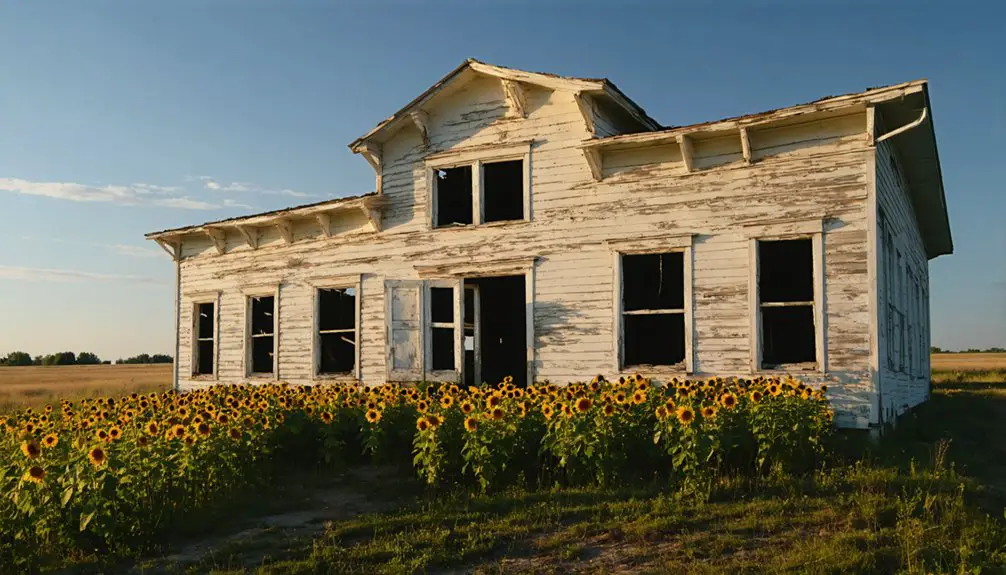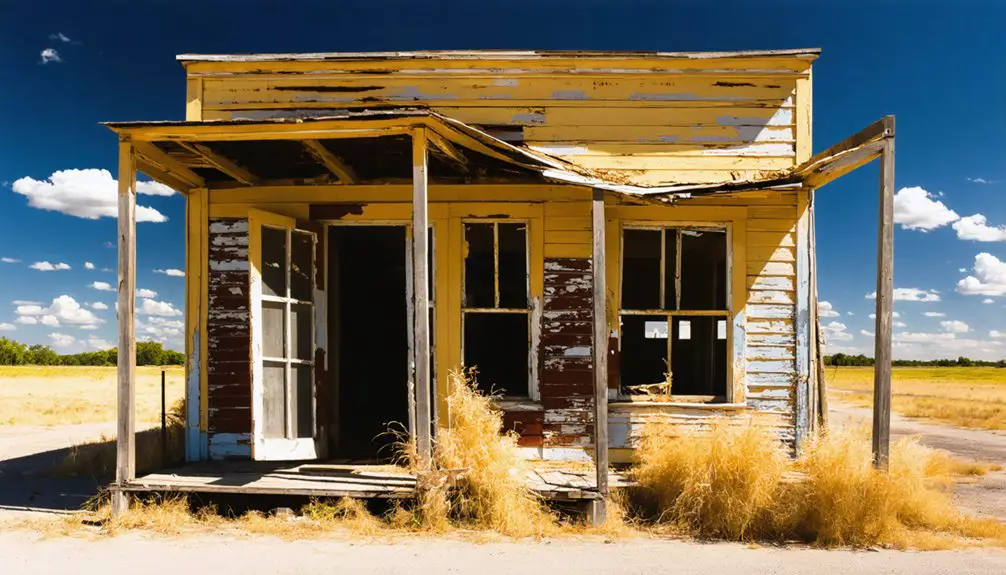You’ll find Comyn’s ghost town remains in Comanche County, Texas, where W.F. Matheney’s trading post first established the settlement as “Theney” in the 1870s. The Texas Central Railroad‘s arrival in 1881 transformed this frontier outpost into a bustling hub, complete with stores, a post office, and oil storage facilities. Today, only rusting oil tanks and vacant lots mark where this once-vibrant community thrived, but beneath the quiet exterior lies a rich tapestry of Texas history.
Key Takeaways
- Comyn evolved from a trading post to a thriving railroad town before declining into a ghost town following economic shifts.
- The closure of the post office in the late 1950s marked a significant turning point in Comyn’s transformation to ghost town status.
- Oil storage tanks from the 1917 boom remain as the most visible remnants of Comyn’s industrial past.
- The community’s decline accelerated after the Theney School’s closure in 1952 and Humble Pipeline Company’s reduced operations.
- Today, Comyn exists as an unincorporated settlement with minimal residential structures and mostly empty lots where businesses once stood.
The Birth of a Trading Post: From Theney to Comyn
When the Native American presence diminished in the 1870s, settlers began establishing themselves in what would become Comyn, Texas. W.F. Matheney seized the opportunity to establish the area’s first trading post, creating a crucial hub for commerce and community gatherings.
The settlement initially took on the name “Theney,” a shortened version of Matheney’s surname that reflected the trading post’s growing importance. Margaret E. Decker became the town’s first postmaster in 1894.
You’ll find that the community’s identity shifted dramatically in 1881 when the Texas Central Railroad extended its line through the area. M.T. Comyn, a railroad official, successfully lobbied to rename the town after himself, though the school maintained its original “Theney” name. The town would later experience significant growth during the oil boom of 1917.
This dual identity marked the settlement’s evolution from a frontier trading post to a promising railroad town.
Railroad Days and Community Growth
The 1881 arrival of the Texas Central Railroad transformed Comyn into a bustling hub of commerce and community life. You’d have witnessed the railroad’s impact firsthand through the construction of a central depot, which quickly became the town’s heart. Much like how greenery covers Moscow, Comyn was surrounded by fertile farmland that supported the local economy.
As trains connected Comyn to wider markets, you’d have seen a surge of new businesses spring up – from general stores and a post office to a drug store and blacksmith shop. The town’s commercial district included a cotton gin and cafe.
The railroad’s influence shaped Comyn’s community identity, even prompting the town’s name change from Theney to honor M.T. Comyn, a railroad official.
The railroad’s arrival did more than connect Comyn to the world – it reshaped the town’s very identity through its new name.
You’d have found a thriving social scene centered around the Woodmen of the World meeting hall, while the formation of Theney Consolidated School in 1924 reflected the growing population’s needs.
These developments created a vibrant small-town culture that would define Comyn’s golden era.
Oil Boom and the Rise of Tent City
Following the discovery of oil in East Texas during 1930-31, Comyn’s landscape transformed dramatically as waves of roughnecks and prospectors flooded into the area.
With no established housing to accommodate the surge of workers, tent city life quickly emerged near the oil fields. You’d find these makeshift settlements teeming with single men living in harsh conditions, braving weather extremes and poor sanitation as they chased their dreams of striking it rich.
The oil boom brought both opportunity and chaos to Comyn. The legendary Dad Joiner’s gusher sparked widespread excitement and drew even more fortune seekers to the region. The discovery helped Texas surpass the Russian Empire in petroleum production by 1940.
While wells in the region produced thousands of barrels daily, the tent cities became hubs of activity, complete with supply stores and informal entertainment venues.
Despite the challenging conditions, a strong sense of camaraderie developed among the workers who shared the wildcatter’s spirit.
Daily Life in Early Comyn
Life in early Comyn stretched far beyond its oil-driven tent cities, centering around a well-established community infrastructure built since 1875. Much like Plemons’ early years, the town experienced rapid growth as settlers and businesses established themselves. The original trading post-store operated by W.F. Matheney marked the beginning of commerce in the area.
Your daily routines would’ve revolved around the town’s essential services, from picking up mail at the post office to visiting the local drug store. Social gatherings at the Woodmen of the World hall brought the community together, while the café and barber shop served as hubs for catching up on local news.
- You’d start your day at one of several general stores for basic provisions
- Cotton farmers would bring their harvest to the local gin for processing
- Children would attend the Theney school, a cornerstone of community life
- Social evenings meant gatherings at the Woodmen hall for community events
- The railroad depot connected you to the wider world beyond Comyn’s borders
Agricultural Shifts and Economic Changes
You’ll find that Comyn’s economic landscape transformed dramatically when peanut farming emerged as the dominant agricultural activity following the decline of the Humble Pipe Line Company’s once-bustling tank farm operations.
The massive oil storage tanks that had defined Comyn’s skyline stood largely empty by mid-century, though some found new purpose as storage facilities for the growing peanut industry. The community’s decline accelerated after the post office closed in the late 1950s.
As family farms struggled to maintain viability in the changing agricultural economy, Comyn’s population dwindled, leaving only scattered remnants of its former prosperity.
Peanut Farming Takes Over
When the Mexican boll weevil devastated cotton crops across Comanche County in 1914, local farmers faced a critical turning point that would reshape the region’s agricultural identity.
The peanut cultivation that followed sparked an economic transformation, with farmers embracing their newfound freedom from cotton dependency. The facility quickly grew to process ten railcar loads daily.
You’ll find that Comyn led this agricultural revolution when N.T. Haskins established the De Leon Peanut Company in 1912, building a massive six-story processing plant by 1917.
- Workers plowed peanuts from the ground by hand
- Pitchforks were used to shake and dry the harvest for days
- Manual threshing separated peanuts from plants
- Farmers bagged peanuts themselves for transport
- Community cooperation was essential for successful harvests
Tank Farm Impact Fades
The agricultural landscape of Comyn experienced a dramatic shift in 1918 as Humble Pipeline Company began constructing a massive tank farm to store West Texas oil.
You’d have seen hundreds of workers pouring into the area, setting up a bustling tent city and temporarily transforming this farming community into an industrial hub.
But the economic change proved short-lived. When tank farm construction ceased in 1919, workers vanished as quickly as they’d arrived.
The brief industrial boom gave way to a return to agriculture, though farming patterns had changed. While smaller family farms persisted, they faced mounting challenges from mechanization and shifting markets.
The once-promising industrial development left Comyn to gradually fade into a quiet, unincorporated settlement, with even the local Theney Consolidated School shuttering by 1952.
Family Farms Decline Steadily
As boll weevils devastated cotton crops across Comanche County between 1900-1930, Comyn’s agricultural foundation began crumbling beneath mounting economic pressures.
You’ll see the harsh reality of family farming’s decline in the numbers – from 4,372 farms in 1910 to just 2,746 by 1925. The economic challenges proved insurmountable for many, forcing a third of farmers to abandon their dreams of agricultural independence.
- Cotton acreage plunged from 89,000 to 39,000 acres between 1900-1910
- Population dropped sharply from 27,186 to 18,748 between 1910-1930
- Cropland harvested fell from 188,606 to 153,604 acres from 1929-1940
- Farm values rose from $14.53 to $2,280 per acre, pricing out small farmers
- Manual labor intensity remained high at 40-50 hours per 100 bushels of wheat
The Legacy of Theney School

Founded in the 1870s alongside W.F. Matheney’s trading post, Theney School established an educational legacy that would shape Comanche County for generations.
You’ll find its origins in the shortened version of Matheney’s name, which stuck even after the town became Comyn.
The school reached its peak after 1924’s consolidation, when you’d have witnessed the construction of a modern campus that became one of the county’s premier high schools.
Throughout economic ups and downs, Theney’s educational impact remained steadfast, serving as the community’s backbone until 1952.
While the buildings are gone now, joining Comyn’s ghost town status, the school’s influence lives on through preserved historical records and the achievements of its alumni, including future Texas Lt. Governor Ben Barnes.
What Remains: A Historic Texas Settlement
Standing along Farm to Market Road 1496, Comyn’s most striking remnants are the massive oil storage tanks that dominate its landscape – silent witnesses to the town’s heyday during the 1917 West Texas oil boom.
While the town’s historic significance lives on through these industrial relics, you’ll find few traces of the once-vibrant community that called this place home. The tanks, some now repurposed for peanut storage, reflect both the area’s industrial past and community resilience in adapting to changing times.
- Original Humble Pipeline Company tanks still tower over the quiet countryside
- Empty lots where stores and businesses once thrived during peak population of 381
- Former tank farm that connected West Texas oil fields to Houston
- Converted storage facilities now serving agricultural purposes
- Minimal remaining residential structures marking this near-ghost town
Frequently Asked Questions
What Happened to the Original Matheney Trading Post Building?
While you’ll find rich Matheney history in local records, you won’t discover the trading post’s ultimate fate – sparse documentation means its physical end remains a mystery after Comyn’s gradual decline.
Were There Any Notable Crimes or Lawlessness During Comyn’s Peak Years?
You won’t find documented crime statistics or notable law enforcement incidents during Comyn’s heyday – historical records show a well-organized, law-abiding community focused on commerce and social development instead.
What Native American Tribes Originally Inhabited the Comyn Area?
The Comanche dominated your area’s tribal history by the 1700s, though Apache, Kiowa, and Wichita peoples contributed to the region’s cultural heritage through their earlier presence in this southern Great Plains territory.
Did Any Famous People or Historical Figures Ever Visit Comyn?
You won’t find many famous visitors in Comyn’s history, except for Lieutenant Governor Ben Barnes who was raised nearby, and M.T. Comyn, the railroad official who gave the town its name.
Are There Any Surviving Photographs of Comyn’s Tent City Period?
You won’t find any confirmed historical photographs of Comyn’s 1918 tent city period in major archives. While regional collections might hold undiscovered images, no verified photos have surfaced in public databases.
References
- https://texashistoricalmarkers.weebly.com/community-of-comyn-theney.html
- https://digitalcommons.unl.edu/cgi/viewcontent.cgi?article=1435&context=greatplainsquarterly
- https://www.ghosttowns.com/states/tx/comyn.html
- https://en.wikipedia.org/wiki/List_of_ghost_towns_in_Texas
- https://www.tshaonline.org/handbook/entries/comyn-tx
- https://www.texasescapes.com/TOWNS/Texas-Ghost-Towns-2-Central-Texas.htm
- https://www.texasescapes.com/CentralTexasTownsNorth/Comyn-Texas.htm
- https://en.wikipedia.org/wiki/Comyn
- https://www.tarleton.edu/library/crosstimbers/collections/rdrcollection/rdr00022p/
- https://www.hmdb.org/m.asp?m=264214



